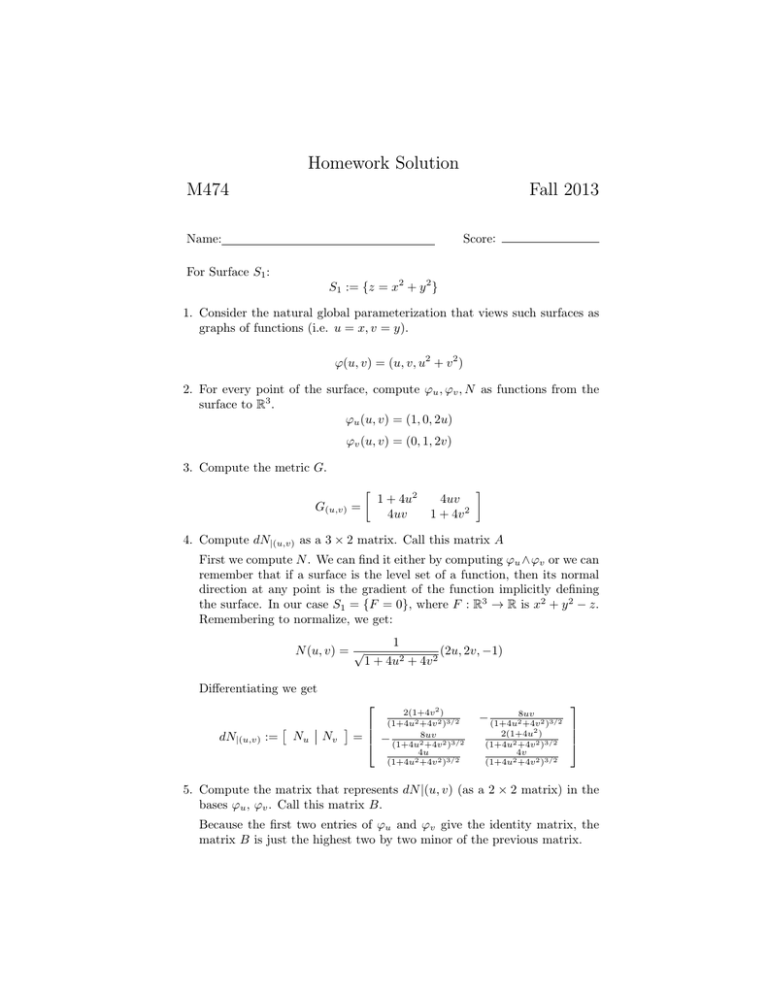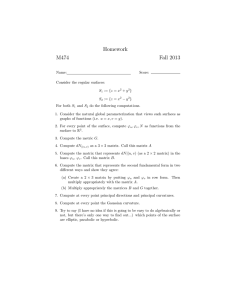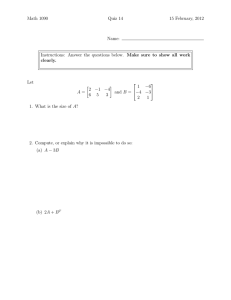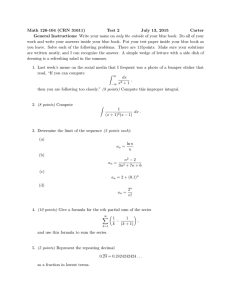Homework Solution M474 Fall 2013
advertisement

Homework Solution
M474
Fall 2013
Name:
Score:
For Surface S1 :
S1 := {z = x2 + y 2 }
1. Consider the natural global parameterization that views such surfaces as
graphs of functions (i.e. u = x, v = y).
ϕ(u, v) = (u, v, u2 + v 2 )
2. For every point of the surface, compute ϕu , ϕv , N as functions from the
surface to R3 .
ϕu (u, v) = (1, 0, 2u)
ϕv (u, v) = (0, 1, 2v)
3. Compute the metric G.
G(u,v) =
1 + 4u2
4uv
4uv
1 + 4v 2
4. Compute dN|(u,v) as a 3 × 2 matrix. Call this matrix A
First we compute N . We can find it either by computing ϕu ∧ϕv or we can
remember that if a surface is the level set of a function, then its normal
direction at any point is the gradient of the function implicitly defining
the surface. In our case S1 = {F = 0}, where F : R3 → R is x2 + y 2 − z.
Remembering to normalize, we get:
N (u, v) = √
1
(2u, 2v, −1)
1 + 4u2 + 4v 2
Differentiating we get
dN|(u,v) :=
Nu
Nv
=
2(1+4v 2 )
(1+4u2 +4v 2 )3/2
− (1+4u28uv
+4v 2 )3/2
4u
2
(1+4u +4v 2 )3/2
− (1+4u28uv
+4v 2 )3/2
2(1+4u2 )
(1+4u2 +4v 2 )3/2
4v
(1+4u2 +4v 2 )3/2
5. Compute the matrix that represents dN |(u, v) (as a 2 × 2 matrix) in the
bases ϕu , ϕv . Call this matrix B.
Because the first two entries of ϕu and ϕv give the identity matrix, the
matrix B is just the highest two by two minor of the previous matrix.
dN|(u,v) = B =
2(1+4v 2 )
(1+4u2 +4v 2 )3/2
− (1+4u28uv
+4v 2 )3/2
− (1+4u28uv
+4v 2 )3/2
2(1+4u2 )
(1+4u2 +4v 2 )3/2
6. Compute the matrix that represents the second fundamental form in two
different ways and show they agree:
(a) Create a 2 × 3 matrix by putting ϕu and ϕv in row form. Then
multiply appropriately with the matrix A.
(b) Multiply appropriately the matrices B and G together.
At the end of the day you get that in the ϕu , ϕv basis the second fundamental form is represented by the matrix:
#
"
2
√
0
2 +4v 2
1+4u
II(u,v) =
2
√
0
1+4u2 +4v 2
7. Compute at every point principal directions and principal curvatures.
Since the paraboloid is a surface of rotation we know that the principal directions are the radial and obviously its orthogonal. We can easily
say they are represented by the vectors (u, v) and (−v, u) - even though
careful!! - these are not the vectors we call in class e1 e2 because they are
not of norm 1.
The principal curvatures are
√
2 1 + 4u2 + 4v 2
2
,√
1 + 8u2 + 8v 2 + 16u4 + 32u2 v 2 + 16v 4
1 + 4u2 + 4v 2
8. Compute at every point the Gaussian curvature.
The determinant of B is:
K = det(B) =
4
1 + 4u2 + 4v 2
9. Try to say (I have no idea if this is going to be easy to do algebraically or
not, but there’s only one way to find out...) which points of the surface
are elliptic, parabolic or hyperbolic.
Obviosuly K > 0 for every (u, v). Every point is elliptic.
For Surface S2 :
S1 := {z = x2 − y 2 }
1. Consider the natural global parameterization that views such surfaces as
graphs of functions (i.e. u = x, v = y).
ϕ(u, v) = (u, v, u2 − v 2 )
2. For every point of the surface, compute ϕu , ϕv , N as functions from the
surface to R3 .
ϕu (u, v) = (1, 0, 2u)
ϕv (u, v) = (0, 1, −2v)
3. Compute the metric G.
G(u,v) =
1 + 4u2
−4uv
−4uv
1 + 4v 2
4. Compute dN|(u,v) as a 3 × 2 matrix. Call this matrix A
Remembering to normalize, we get:
N (u, v) = √
1
(2u, −2v, −1)
1 + 4u2 + 4v 2
Differentiating we get
dN|(u,v) :=
Nu
Nv
=
2(1+4v 2 )
(1+4u2 +4v 2 )3/2
8uv
(1+4u2 +4v 2 )3/2
4u
(1+4u2 +4v 2 )3/2
− (1+4u28uv
+4v 2 )3/2
2(1+4u2 )
− (1+4u
2 +4v 2 )3/2
4v
(1+4u2 +4v 2 )3/2
5. Compute the matrix that represents dN |(u, v) (as a 2 × 2 matrix) in the
bases ϕu , ϕv . Call this matrix B.
Because the first two entries of ϕu and ϕv give the identity matrix, the
matrix B is just the highest two by two minor of the previous matrix.
dN|(u,v) = B =
2(1+4v 2 )
(1+4u2 +4v 2 )3/2
8uv
(1+4u2 +4v 2 )3/2
− (1+4u28uv
+4v 2 )3/2
2
2(1+4u )
− (1+4u
2 +4v 2 )3/2
6. Compute the matrix that represents the second fundamental form in two
different ways and show they agree:
(a) Create a 2 × 3 matrix by putting ϕu and ϕv in row form. Then
multiply appropriately with the matrix A.
(b) Multiply appropriately the matrices B and G together.
At the end of the day you get that in the ϕu , ϕv basis the second fundamental form is represented by the matrix:
"
#
2
√
0
2 +4v 2
1+4u
II(u,v) =
0
− √1+4u22 +4v2
7. Compute at every point principal directions and principal curvatures. The
principal directions are kind of ugly, so let me not write them, however
one notices that having lost the rotational symmetry now they are a lot
more complicated. The principal curvatures are:
√
−4u2 + 4v 2 ± 2 1 + 4v 2 + 4u2 + 4u4 − 8u2 v 2 + 4v 4
(1 + 4u2 + 4v 2 )3/2
8. Compute at every point the Gaussian curvature.
The determinant of B is:
K = det(B) = −
4
1 + 4u2 + 4v 2
9. Try to say (I have no idea if this is going to be easy to do algebraically or
not, but there’s only one way to find out...) which points of the surface
are elliptic, parabolic or hyperbolic.
Obviosuly K < 0 for every (u, v). Every point is hyperbolic.





